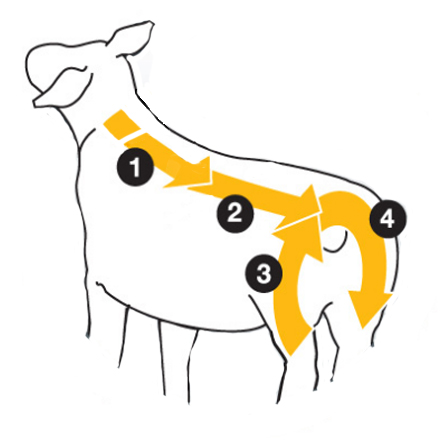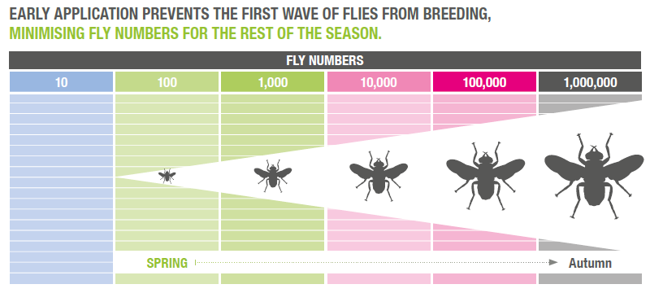Clikzin Pour-On for sheep protects against blowfly strike for up to 8 weeks. Clikzin Pour-On also has a short withdrawal period of only 7 days making it the ideal product for lambs going to slaughter.
Active Ingredient: Dicyclanil
Target Species: Sheep
Treats and Controls: Blowfly strike
Administration Method: Pour-On
Length of Protection: 8 Weeks
Withdrawal Time: 7 days for sheep intended for meat and offal. Not recommended for sheep producing milk for human consumption
Dosage for sheep: 0.7-2 ml per 1 kg of bodyweight.
| Body Weight | Dose Volume | Number of worm doses per pack | |
| 2.2 Litre | 5 Litre | ||
| 10-20kg | 20 ml | 110 | 250 |
| 21-30kg | 24 ml | 91 | 208 |
| 31-50kg | 30 ml | 73 | 166 |
| >50kg | 36 ml | 61 | 138 |
Always read the label and all enclosed information for Clikzin Pour-On before administering to animals!
BLOWFLY REPORTING
Elanco AH have created an e-Form which is how you will report any blowfly complaints this year.
This can be done on your smart phone or on a PC, Laptop or iPad using the link below.
How it works:
When the form is completed we get the data instantly and log the details supplied, giving it a PV reference number. We then send an email to the reporter with the PV ref. and tell them an Elanco colleague will call the farmer to get further details and to investigate – this will be a member of our Pharmacovigilance team.
https://forms.office.com/r/b8sGNqMVDD
How to apply Clikzin Pour-On
Clikzin Pour-on should be applied using the four stroke method as outlined below. It is recommended that Clikzin Pour-On is applied using the proper gun which features a fan spray nozzle. The gun can be found by clicking here.
The Four Stroke Method: The four stroke method ensures the pour-on is applied evenly by applying a quarter of the application at a time in four simple strokes.
1) 1/4 applied from between the shoulders to middle of back
2) 1/4 applied from middle of back to top of animals tail
3) 1/4 applied from one side of the animals tail down the crutch
4) 1/4 applied from other side of tail down the other crutch

This Product is only licensed for sale in the Republic of Ireland
Click here to Download Data Sheet
1 NAME OF THE VETERINARY MEDICINAL PRODUCT
Clikzin 1.25% (w/v) Pour-On Suspension for Sheep.
2 QUALITATIVE AND QUANTITATIVE COMPOSITION
Active substance:
Dicyclanil (INN), 12.5mg/ml (1.25% w/v)
Excipient(s):
Colouring matters:
Quinoline yellow (E104) 0.005 % (w/v)
Patent blue V (E131) 0.005 % (w/v)
Preservatives:
Methyl parahydroxybenzoate (E218) 0.15% (w/v)
Propyl parahydroxybenzoate (E216) 0.30% (w/v)
Butylated hydroxytoluene (E321) 0.05% (w/v)
For a full list of excipients, see section 6.1.
3 PHARMACEUTICAL FORM
Pour-on suspension.
4 CLINICAL PARTICULARS
4.1 Target Species
Sheep.
4.2 Indications for use, specifying the target species
Prevention of blowfly strike on sheep due to Lucilia sericata.
4.3 Contraindications
Do not use in case of hypersensitivity to the active substance or any of the excipients.
4.4 Special warnings for each target species
The product is best applied before an anticipated blowfly challenge, or when a blowfly challenge is identified on or in
the vicinity of the farm. Established strikes may require a separate treatment with a knockdown insecticide.
It is recommended that animals with dirty back-ends are dagged or crutched prior to application.
If dagging or crutching is undertaken in the weeks following application, these animals should be re-treated, otherwise protection could be lost.
Do not apply during heavy rainfall, or when such conditions are expected. The resulting wash out may reduce the
protection period.
4.5 Special precautions for use
Special precautions for use in animals
Not applicable.
Special precautions to be taken by the person administering the veterinary medicinal product to animals
• Operators should wear synthetic rubber gloves and PVC trousers when applying the product.
• In case of skin contact remove contaminated clothing and thoroughly wash the affected parts of the body with
soap and water.
• In case of eye contact, wash immediately with clean water.
• Always wash hands and exposed skin with soap and water after work.
• Do not eat, drink or smoke whilst using the product.
• It is good agricultural practice to minimise handling of sheep after treatment. If you need to handle sheep within 2
months after treatment, wear synthetic rubber gloves and long trousers or coveralls. If sheep are wet wear
waterproof trousers.
Other precautions
• Treated sheep must be kept away from watercourses for at least one hour after treatment. There is a serious risk
to aquatic life if this advice is not followed.
4.6 Adverse reactions (frequency and seriousness)
None known.
4.7 Use during pregnancy, lactation or lay
The safety of the veterinary medicinal product has not been established during pregnancy or lactation.
Use only accordingly to the benefit/risk assessment by the responsible veterinarian.
Laboratory studies in rats and rabbits have not shown any evidence of teratogenic, foetotoxic or maternotoxic effects.
4.8 Interaction with other medicinal products and other forms of interaction
None known.
4.9 Amounts to be administered and administration route
For external use only.
The veterinary medicinal product is applied according to the following recommendations:
(Guide dose volumes correspond to 0.7–2 ml (7.5–25 mg dicyclanil) per kg bodyweight.)
Recommended for treatment in sheep 3 weeks post shearing.
Shake the container well before use.
The veterinary medicinal product must be applied with a manual or automatic dosing gun, fitted with a spray nozzle,
which guarantees the correct spreading of the product on the fleece.
Best results will be achieved by holding the gun approximately 45 cm from the sheep during application.
Apply as a fan spray along the spine of the animal in bands at least 10 cm wide from the middle of the shoulders and in an arc around the crutch and tail.
Half the dose should be applied along the spine with the remainder over the tail and crutch area.
The veterinary medicinal product should be administered before or at the start of predicted fly activity but is also suitable for use during the fly season.
The veterinary medicinal product will protect against fly strike for 8 weeks.
It is good agricultural practice to check animals regularly for fly strike.
4.10 Overdose (symptoms, emergency procedures, antidotes), if necessary
An overdose of up to at least 20 times the recommended dose does not lead to any signs of local or systemic
intolerance. No antidote is known.
4.11 Withdrawal Period(s)
Meat and offal: 7 days
Do not use on sheep producing milk for human consumption.
5 PHARMACOLOGICAL or IMMUNOLOGICAL PROPERTIES
Pharmacotherapeutic group:
Other ectoparasiticides for topical use.
ATC vet code.
QP53AX24.
5.1 Pharmacodynamic properties
Dicyclanil prevents the moult from the first to the second larval instar of Lucilia spp. It is less effective against later
larval stages and does not have any adulticide action. The mode of action of dicyclanil is believed to be similar to that
of the triazine compounds.
Body weight (kg) Dose volume (ml)
10-20 20
21-30 24
31-50 30
>50 36
5.2 Pharmacokinetic properties
In studies with a more concentrated 5% (w/v) formulation, after 7 days post dosing, approximately 5% of the dose was absorbed and eliminated in urine and faeces.
Peak blood levels were observed between 12 and 48h post dose, accounting for <0.025 mg dicyclanil equivalents/kg.
In experimental metabolism studies, absorbed radioactivity was widely distributed throughout the body.
Longest half lives were found in liver and kidney being 13 and 10 days respectively. In muscle, fat and wool, unchanged dicyclanil was found to be the major residue, whereas in liver and kidney the descyclopropyl dicyclanil was found to be the major residue together with unchanged dicyclanil.
In field residue depletion studies on sheep with the veterinary medicinal product, residue levels at day 7 were very low (at maximum 31.9 and 30.7 μg/kg in liver and kidney, respectively, and no quantifiable residues found in muscle or fat), indicating minimal systemic absorption.
Environmental properties
The use of the veterinary medicinal product has harmful effects on dung flies and beetles.
6 PHARMACEUTICAL PARTICULARS
6.1 List of excipients
Quinoline yellow (E104)
Patent blue V (E131)
Methyl parahydroxybenzoate (E218)
Propyl parahydroxybenzoate (E216)
Butylated hydroxytoluene (E321)
Polysorbate 20
Acrylic acid copolymer
Disodium edetate
Distilled monoglycerides
Triglycerides, medium-chain
Propylene glycol
Sodium hydroxide
Purified water
6.2 Incompatibilities
Not applicable.
6.3 Shelf-life
Shelf-life of the veterinary medicinal product as packed for sale: 36 months.
Shelf-life after first opening of the immediate packaging: 12 months
6.4 Special precautions for storage
Protect from direct sunlight.
Protect from frost.
Store in tightly closed original containers, away from food, drink and animal feedstuffs.
6.5 Nature and composition of immediate packaging
The pack is composed of pigmented white opaque polyethylene back pack container with blue polypropylene screw
cap, containing 0.8, 2.2 or 5 litres of finished product. Not all pack sizes may be marketed.
6.6 Special precautions for the disposal of unused veterinary medicinal products or waste materials
Any unused veterinary medicinal product or waste materials derived from such veterinary medicinal products should be disposed of in accordance with local requirements.
Harmful to aquatic invertebrates.
Do not contaminate ponds or other waterways with product or empty containers.
7 MARKETING AUTHORISATION HOLDER
Novartis Animal Health UK Ltd
Frimley Business Park
Frimley
Surrey
GU16 7SR
England
8 MARKETING AUTHORISATION NUMBER(S)
VPA: 10825/024/001
9 DATE OF THE FIRST AUTHORISATION/RENEWAL OF THE AUTHORISATION
24th September 2010
10 DATE OF REVISION OF THE TEXT
August 2011
Sheep Pour-ons and spot-ons
Pour-ons and spot-ons need to be applied accurately and each manufacturer may recommend subtle differences. Use appropriate and calibrated guns, always clean with warm soapy water and then rinse after use. Store in a safe dry place. When treating sheep with these products, make sure they are applied along the back line. If placed to one side, the product will not spread evenly around the body. No pour-on or spot-on is effective against sheep scab.

The Four Stroke Method: The four stroke method ensures the pour-on is applied evenly by applying a quarter of the application at a time in four simple strokes.
1) 1/4 applied from between the shoulders to middle of back
2) 1/4 applied from middle of back to top of animals tail
3) 1/4 applied from one side of the animals tail down the crutch
4) 1/4 applied from other side of tail down the other crutch
WHAT IS BLOWFLY STRIKE?
Blowfly is the main external parasite traditionally affecting sheep in the late spring and summer months. Changing weather patterns have resulted in an increasingly unpredictable and lengthening season. Blowflies are attracted to lay their eggs on areas of soiling or damage (wounds) on the animal, or on carcasses. Therefore, the key to blowfly control is to minimise breeding opportunities by:

Would you like to send this voucher to the recipient via email?
Yes No